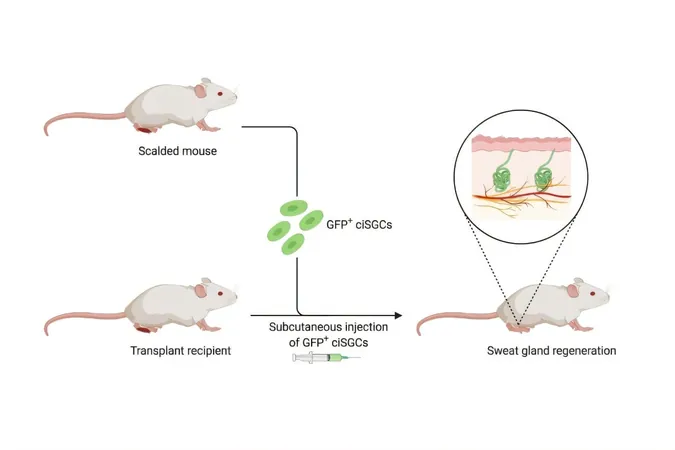
Revolutionary Non-Genetic Method Could Transform Burn Recovery by Restoring Sweat Gland Function!
2024-11-22
Author: John Tan
Introduction
Sweat glands play a crucial role in maintaining body temperature, fluid balance, and overall skin health. When severe skin injuries, such as burns, occur, these essential glands can be lost, leading to serious complications like overheating and dehydration. For a long time, regenerating sweat glands has posed a significant challenge for medical science. However, that may be about to change!
Groundbreaking Research
Exciting new research has unveiled a groundbreaking non-genetic reprogramming technique that shows great promise in restoring sweat gland function. A dedicated team of scientists has successfully developed a method using a blend of six chemicals that convert human epidermal keratinocytes (HEKs)—the predominant type of skin cells—into sweat gland-like cells, now referred to as chemically induced sweat gland cells (ciSGCs). This remarkable study is featured in the prestigious journal Science Bulletin.
ciSGCs and Their Functionality
The ciSGCs demonstrated an impressive resemblance to natural sweat gland cells, both in terms of structure and function. Laboratory experiments have revealed that these reprogrammed cells can self-renew, differentiate into sweat-secreting cells, and express essential sweat gland markers. Even more fascinating, when these engineered cells were transplanted into the damaged skin of mice, they not only accelerated the wound healing process but also successfully reconstructed the skin’s dermal architecture, leading to the regeneration of fully functional sweat glands.
Thermoregulatory Sweating Restoration
One of the standout findings of this research is the ability of ciSGCs to restore thermoregulatory sweating—the vital process that enables the body to cool down after overheating—within burnt skin. Beyond merely taking the place of lost glands, these innovatively engineered cells also release bioactive factors that encourage nearby cells to repair and rejuvenate the damaged tissue, significantly enhancing healing outcomes.
Safety and Scalability
In contrast to earlier methods that involved genetic modifications—which raised serious safety concerns, including the risk of cancer—the team’s new pharmacological approach utilizes small molecules to alter cellular identity without interfering with the DNA. This non-genetic method is not only safer but also scalable and adaptable, paving the way for future clinical applications.
Implications for Patients
For patients suffering from severe skin injuries caused by burns, this technique opens the door to the complete regeneration of damaged tissue and the restoration of vital functions. It represents a significant advance in personalized regenerative medicine, addressing both the physical and emotional repercussions of severe skin injuries, which can be profound.
Future Directions
As the research team continues their work to refine and optimize this innovative technique, the potential for real-world clinical application is expanding rapidly. This revolutionary breakthrough could one day transform burn care practices and bring newfound hope to patients across the globe!
Conclusion
Stay tuned as we monitor further developments in this exciting field, as the possibility of life-changing treatments for burn victims moves closer to reality!


 Brasil (PT)
Brasil (PT)
 Canada (EN)
Canada (EN)
 Chile (ES)
Chile (ES)
 España (ES)
España (ES)
 France (FR)
France (FR)
 Hong Kong (EN)
Hong Kong (EN)
 Italia (IT)
Italia (IT)
 日本 (JA)
日本 (JA)
 Magyarország (HU)
Magyarország (HU)
 Norge (NO)
Norge (NO)
 Polska (PL)
Polska (PL)
 Schweiz (DE)
Schweiz (DE)
 Singapore (EN)
Singapore (EN)
 Sverige (SV)
Sverige (SV)
 Suomi (FI)
Suomi (FI)
 Türkiye (TR)
Türkiye (TR)